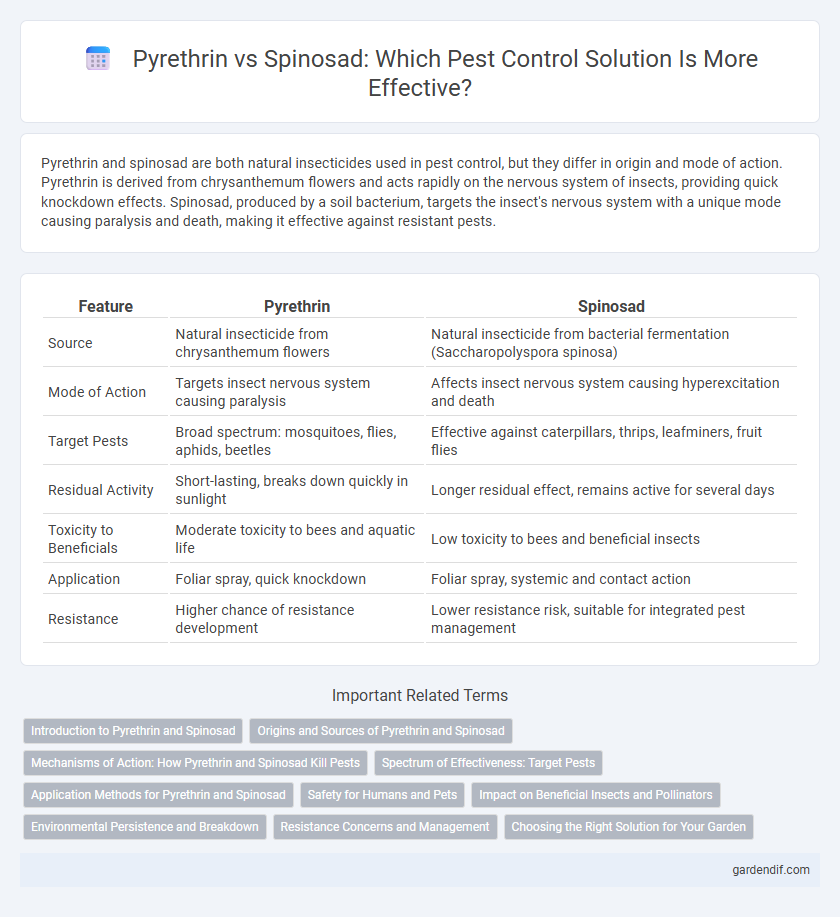
Pyrethrin vs spinosad Illustration
Pyrethrin and spinosad are both natural insecticides used in pest control, but they differ in origin and mode of action. Pyrethrin is derived from chrysanthemum flowers and acts rapidly on the nervous system of insects, providing quick knockdown effects. Spinosad, produced by a soil bacterium, targets the insect's nervous system with a unique mode causing paralysis and death, making it effective against resistant pests.
Table of Comparison
| Feature | Pyrethrin | Spinosad |
|---|---|---|
| Source | Natural insecticide from chrysanthemum flowers | Natural insecticide from bacterial fermentation (Saccharopolyspora spinosa) |
| Mode of Action | Targets insect nervous system causing paralysis | Affects insect nervous system causing hyperexcitation and death |
| Target Pests | Broad spectrum: mosquitoes, flies, aphids, beetles | Effective against caterpillars, thrips, leafminers, fruit flies |
| Residual Activity | Short-lasting, breaks down quickly in sunlight | Longer residual effect, remains active for several days |
| Toxicity to Beneficials | Moderate toxicity to bees and aquatic life | Low toxicity to bees and beneficial insects |
| Application | Foliar spray, quick knockdown | Foliar spray, systemic and contact action |
| Resistance | Higher chance of resistance development | Lower resistance risk, suitable for integrated pest management |
Introduction to Pyrethrin and Spinosad
Pyrethrin is a natural insecticide derived from chrysanthemum flowers, widely used for quick knockdown of pests like mosquitoes and flies due to its rapid neurotoxic effects. Spinosad, a biologically-based pesticide produced by the fermentation of Saccharopolyspora spinosa bacteria, targets a broad spectrum of pests by disrupting their nervous system with minimal impact on beneficial insects. Both pyrethrin and spinosad offer effective pest control, but they differ significantly in their sources, modes of action, and environmental safety profiles.
Origins and Sources of Pyrethrin and Spinosad
Pyrethrin is a natural insecticide derived from the dried flowers of Chrysanthemum cinerariifolium and Chrysanthemum coccineum, widely cultivated for their high pyrethrin content. Spinosad is produced through the fermentation of the soil bacterium Saccharopolyspora spinosa, making it a biologically-based pesticide with distinct microbial origins. Both compounds are favored for their natural sources, contributing to their effectiveness in integrated pest management strategies.
Mechanisms of Action: How Pyrethrin and Spinosad Kill Pests
Pyrethrin disrupts the nervous system of pests by targeting sodium channels, causing paralysis and rapid death. Spinosad affects nicotinic acetylcholine receptors, inducing hyperexcitation of the insect nerves and muscles, leading to exhaustion and death. Both compounds offer effective pest control but operate through distinct neurotoxic pathways.
Spectrum of Effectiveness: Target Pests
Pyrethrin is a broad-spectrum insecticide effective against a wide range of flying and crawling pests, including mosquitoes, flies, fleas, and beetles. Spinosad, derived from natural soil bacteria, targets specific pests such as thrips, leafminers, spider mites, and caterpillars while being safer for beneficial insects. The selectivity of spinosad makes it ideal for integrated pest management programs focused on preserving beneficial arthropods.
Application Methods for Pyrethrin and Spinosad
Pyrethrin is primarily applied as a contact insecticide through sprays, aerosols, or foggers, effectively targeting flying and crawling insects on contact. Spinosad is commonly used as a foliar spray or soil drench, allowing systemic absorption to control a wider range of pests like caterpillars, leafminers, and thrips. Both are suitable for organic farming, but spinosad's residual activity often provides longer-lasting pest control compared to the rapid knockdown effect of pyrethrin.
Safety for Humans and Pets
Pyrethrin and spinosad are both insecticides effective against a variety of pests, but spinosad is generally considered safer for humans and pets due to its natural fermentation origin and lower toxicity. Pyrethrin, derived from chrysanthemum flowers, can cause allergic reactions and respiratory issues in sensitive individuals and pets. Spinosad breaks down quickly in the environment and poses minimal risk when used according to label instructions, making it a preferable choice for safer pest control in homes with children and animals.
Impact on Beneficial Insects and Pollinators
Pyrethrin, a natural insecticide derived from chrysanthemum flowers, exhibits broad-spectrum toxicity that can harm beneficial insects and pollinators such as bees and ladybugs. Spinosad, produced by the bacterium Saccharopolyspora spinosa, targets specific pests with minimal impact on non-target beneficial insects, making it a safer option for integrated pest management. Research indicates spinosad's selective mode of action reduces collateral damage to ecosystems and supports pollinator population health more effectively than pyrethrin.
Environmental Persistence and Breakdown
Pyrethrin exhibits rapid environmental breakdown, with a half-life of less than 24 hours in sunlight, making it less persistent and reducing long-term environmental impact. Spinosad, while also biodegradable, has a longer environmental persistence, with a half-life ranging from 2 to 30 days depending on soil composition and climatic conditions. Both compounds degrade primarily through microbial activity and photolysis, but pyrethrin's swift degradation minimizes accumulation in ecosystems compared to the more stable spinosad.
Resistance Concerns and Management
Pyrethrin, derived from chrysanthemum flowers, often faces resistance in pest populations due to its widespread use and rapid knockdown effect, leading to decreased efficacy over time. Spinosad, a bacterial fermentation product, shows lower resistance development because of its unique mode of action targeting insect nervous systems differently than pyrethrin. Integrating rotation strategies and combining spinosad with pyrethrin can effectively manage resistance by reducing selective pressure on pest populations.
Choosing the Right Solution for Your Garden
Pyrethrin and spinosad are effective natural insecticides commonly used for garden pest control, with pyrethrin offering broad-spectrum activity against a wide range of insects and spinosad targeting specific pests like thrips, caterpillars, and leafminers. Pyrethrin acts quickly but breaks down rapidly in sunlight, making it ideal for short-term pest outbreaks, while spinosad provides longer-lasting control due to its residual effects. Selecting between pyrethrin and spinosad depends on the pest species present, the desired duration of control, and environmental safety considerations for beneficial insects and pollinators in your garden.
Pyrethrin vs spinosad Infographic

 gardendif.com
gardendif.com